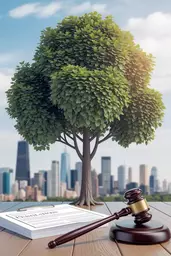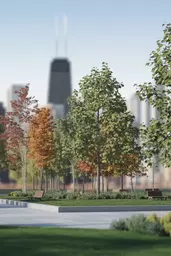Public Safety
- Reducing Hazards
- Minimizing Risk of Falling Branches
Subscribe to get expert tips and the latest insights on tree care and urban greening directly to your inbox.
Posted on: 2025-06-08
By: Keira Vallejo
As winter approaches, urban trees face immense challenges that can weaken their health and vitality. Protecting these trees is not just about aesthetics; it's essential for maintaining a thriving urban ecosystem. What steps can we take to ensure their survival through the cold months?
Understanding the importance of winter tree care involves recognizing its various benefits. Below is a side-by-side comparison of the key benefits of winter tree protection for public safety and environmental health.
As the chill of winter sets in, it’s essential to think about our urban trees and how to keep them safe. Did you know that winter can be one of the most challenging seasons for city trees? Just like us, they need extra care to survive the cold months ahead!
Winter tree protection is crucial for several reasons. Urban trees face harsh conditions such as freezing temperatures, heavy snow, and icy winds that can cause physical damage. Additionally, environmental stress can weaken trees, making them more susceptible to diseases and pests. So, as we bundle up in our warmest coats, we must also ensure our trees are well-prepared to weather the winter.
Why is it so important to consider benefits of professional tree care? Winter can be a particularly challenging time for urban trees. These trees often require professional assistance to ensure they remain healthy and resilient.
Our trees play a vital role in the city ecosystem—they provide shade, improve air quality, and enhance our overall well-being. By protecting them in winter, we ensure they remain healthy and vibrant. Here are a few reasons why winter tree protection is so important:
Taking steps to protect our trees during winter ultimately leads to stronger, healthier trees that enhance urban life. At Urban Canopy Blog, we believe in empowering our community with knowledge to foster thriving city landscapes!
When we invest time in winter tree care, we're not just helping individual trees; we're also promoting public safety and environmental health. Healthy trees contribute to safer urban environments by:
These benefits illustrate the importance of protecting our urban trees throughout the winter months. It's not just about aesthetics—it's about creating safer, healthier communities. So, let’s work together to ensure our trees thrive even in the cold! Remember, every bit of care we give now sets the stage for a lush, green spring.
Did you know? Regularly inspecting your trees for signs of stress can make a significant difference in their winter survival. Look for symptoms like leaf discoloration or reduced growth, and take immediate action if you notice any issues. Early intervention can help your trees thrive through the winter months!
Salt may keep our roads safe during winter, but it can wreak havoc on our urban trees over time. The prolonged exposure to salt not only affects the immediate health of trees but can also lead to long-term soil degradation. Understanding how salt impacts our environment is crucial for anyone interested in maintaining a thriving urban landscape.
One of the first things to notice is how salt build-up can change soil structure and water retention abilities. When salt accumulates, it can lead to dryness and compaction, making it difficult for trees to absorb the necessary nutrients and water. This creates a vicious cycle where trees become weaker and more susceptible to disease and pests.
To tackle the issue of salt build-up, we need to recognize the signs early. Common indicators include leaf discoloration, stunted growth, and even branch dieback. If you've spotted any of these issues in your local trees, it might be time to investigate further!
Addressing these symptoms promptly can help prevent further damage. Regular soil testing is a great way to gauge salt levels and take action before it's too late. You can also seek advice from local experts to understand the best practices for your specific area. To maintain the best possible soil health for your trees, it's important to understand the importance of soil quality and urban trees.
As time goes on, recognizing the signs of salt damage becomes increasingly important. Trees may show delayed effects which can be mistaken for other issues. Observing the following signs can help you catch salt damage early:
It's essential to stay vigilant, as these symptoms often indicate that our trees need intervention. Pay attention to the urban landscape around you, and don't hesitate to act if you notice these warning signs.
If you find that your trees have been affected by salt, don't fret! There are several restoration practices that can help rehabilitate them. Here are some effective strategies to consider:
Each of these steps contributes to rebuilding the tree’s strength and vitality. Remember, trees, much like us, can bounce back with proper care and attention!
Real-world examples can provide valuable insights into effective winter tree care. By looking at successful urban forestry initiatives, we can learn what works and what doesn’t. It's inspiring to see how other cities are tackling the challenges posed by winter conditions and tree protection.
Many cities have developed innovative programs for protecting their trees during winter. Here are a few key examples:
Such initiatives demonstrate that with the right approach, urban areas can thrive even through winter hardships. By rallying community support, cities can boost their tree care efforts significantly!
Here are some frequently asked questions about winter tree protection:
Several cities around the country have launched programs aimed at winter tree protection. Programs that combine education, community involvement, and proactive care strategies have shown remarkable results. For example, a city might offer workshops on winter tree care, helping residents take an active role in protecting their local greenery.
When thinking about implementing such programs it is crucial to consider choosing trees for your climate.
Not every initiative is a success, but even setbacks provide valuable lessons. When looking at various case studies, we can identify common pitfalls and triumphs:
By learning from both successes and failures, we can refine our approaches to urban tree care, ensuring that our city trees remain healthy and resilient.
Community involvement is key to successful winter tree protection. By rallying together, we can create a supportive environment for our trees to thrive. Engaging local groups in tree care initiatives not only benefits the trees themselves but also fosters a sense of community pride.
Working together as a community can lead to impactful changes. Encouraging neighborhood gatherings or workshops can raise awareness about the importance of winter tree care. Here are some ideas to get started:
By promoting awareness, we inspire action, and together, we can make a difference in maintaining the beauty and health of our urban landscapes.
Getting local community groups involved can help spread the word about effective tree care practices. Collaborating with schools, environmental organizations, and local governments can amplify efforts. It creates a shared responsibility for the trees that enhance our urban spaces!
When in doubt, seeking professional advice can be a game changer. Certified arborists possess the expertise needed to assess tree health and provide tailored recommendations. Here are a few reasons why consulting an arborist is a smart move:
By tapping into their knowledge, we can ensure our community trees receive the best care possible!
Finding a certified arborist in your area is easier than you might think. Local tree care services often employ certified professionals who can offer valuable insights. Don't hesitate to reach out to them for assistance!
Consulting an arborist during winter is especially important for identifying any winter stress on trees. They can recommend protective measures that may not be apparent to the untrained eye. The sooner we act, the better prepared our trees will be to face the elements!
As we wrap up our discussion on winter tree protection, it's essential to recap the key strategies we've explored. With a little effort and attention, we can keep our city trees safe and thriving through the colder months. Here are the top practices to remember:
By implementing these strategies, we can work together to enhance the health and vitality of our urban trees. It’s not just about the trees; it’s about creating a greener, more vibrant city for all of us!
Now that you have these strategies in hand, what are your next steps? I encourage you to share your tree care experiences or engage with your community to promote winter tree protection. Let's make a difference together! And don't forget to check out our guide to autumn care for urban trees to prepare for the upcoming seasons.
Here is a quick recap of the important points discussed in the article:

 In urban environments, trees are often the unsung heroes contributing to our well-being and the over
In urban environments, trees are often the unsung heroes contributing to our well-being and the over
 Urban trees are essential to our cities, yet they face numerous threats from pests and diseases. Did
Urban trees are essential to our cities, yet they face numerous threats from pests and diseases. Did
 Did you know that urban tree diversity is crucial not just for aesthetics, but for the health of ent
Did you know that urban tree diversity is crucial not just for aesthetics, but for the health of ent